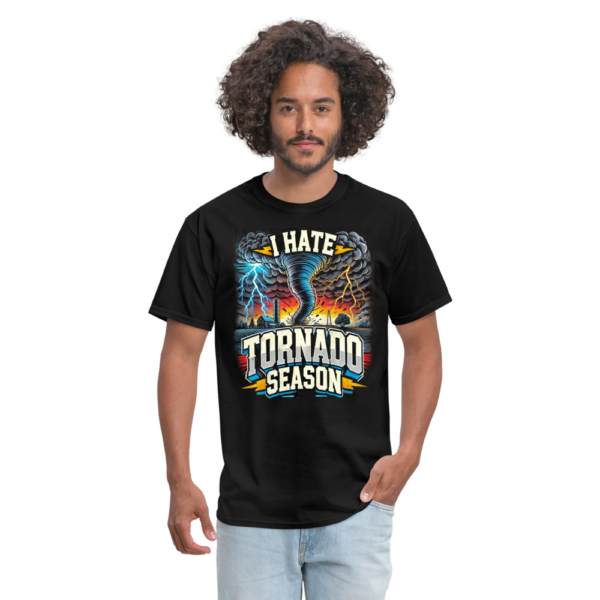Your cart is currently empty!
Tag: emergency planning
The New Tornado Alley: Navigating the Shifting Storms and How to Prepare for Severe Weather
Tornadoes have always been a natural force to be reckoned with, known for their sheer power and unpredictability. Traditionally, the central United States, often referred to as Tornado Alley, was the prime hotspot for these storms. However, recent weather trends have pointed to a significant change. We are now witnessing the emergence of what many meteorologists are calling the “New Tornado Alley.” This evolving landscape of severe weather means that areas once considered safe are now at risk. In this comprehensive guide, we’ll explore where this new zone is emerging, why the shift is happening, and most importantly, how you can prepare to protect yourself, your loved ones, and your property from the fury of nature. Don’t forget to comment and share your thoughts below!
Where is the New Tornado Alley?
In the past, states like Texas, Oklahoma, Kansas, and Nebraska were the primary regions affected by tornadoes. However, recent weather patterns have shown a noticeable eastward shift. Areas in the southeastern United States, including parts of Mississippi, Alabama, Arkansas, Tennessee, and even portions of the Mid-Atlantic region, are now experiencing more frequent and intense tornado activity. This shift means that communities that historically did not have to prioritize tornado preparedness are now facing the real threat of severe weather events.
Meteorologists explain that several factors, such as shifting climate patterns, have contributed to these changes. Warmer temperatures, increased humidity, and alterations in jet stream patterns are creating the perfect recipe for tornado formation in these new regions. As a result, residents in these areas need to take a closer look at their emergency plans and ensure they’re adequately prepared.
Why is Tornado Activity Shifting?
Climate Change and Its Role
One of the most significant contributors to the changing landscape of tornado activity is climate change. The warming of the planet affects not just average temperatures but also alters weather patterns on a global scale. Warmer air can hold more moisture, which in turn fuels severe storms. The increase in atmospheric instability creates conditions that are conducive to tornado formation. As these climatic conditions become more prevalent in areas outside the traditional Tornado Alley, the risk of tornadoes increases.
Shifts in Atmospheric Patterns
The behavior of large-scale weather systems such as the jet stream has also changed over recent decades. The jet stream, which acts like a giant river of air high in the atmosphere, plays a crucial role in steering storm systems. Recent studies have shown that changes in the jet stream’s path are leading to more erratic and widespread severe weather patterns. This means that regions previously unaffected by tornadoes may now experience the severe storms that were once isolated to the central United States.
Urbanization and Reporting Improvements
Another factor contributing to the perception of a new tornado zone is the rapid urbanization of previously rural areas. With more people living in regions that were once sparsely populated, there is a higher likelihood of tornadoes being reported and documented. Enhanced technology and improved communication systems have made it easier for meteorologists to track and report tornado activity, which also adds to the awareness of this shift.
How to Prepare for Tornadoes in the New Tornado Alley
Develop a Comprehensive Emergency Plan
The first step in tornado preparedness is creating a detailed emergency plan. Every household should have a clear and practiced plan in place. Here are some key components:
- Designate a Safe Space: Identify an interior room on the lowest level of your home with no windows. This could be a basement, storm cellar, or an interior room like a bathroom. Make sure all family members know where to go during a tornado.
- Establish Communication Protocols: Develop a plan for how your family will communicate in case cell towers go down or lines are disrupted. Consider a meeting point outside your home if you become separated.
- Practice Regular Drills: Just like fire drills, practice tornado drills regularly. Ensure every member of your family understands the plan and knows the steps to take when a tornado warning is issued.
Build an Emergency Kit
Having an emergency kit is essential for surviving any disaster, including tornadoes. Your kit should include:
- Non-perishable Food and Water: Store enough supplies to last at least 72 hours. This includes canned foods, water, and other non-perishable items.
- First-Aid Supplies: A comprehensive first-aid kit should be readily available, along with any necessary prescription medications.
- Emergency Tools: Include items such as a flashlight, extra batteries, a portable radio, and a multi-tool. Consider a whistle for signaling help.
- Important Documents: Keep copies of essential documents such as identification, insurance papers, and medical records in a waterproof container.
- Comfort Items: For families with children, having some comfort items, like toys or blankets, can help reduce anxiety during stressful times.
Secure Your Home and Property
Tornadoes can cause significant damage to homes and properties. Here are some practical steps to minimize damage:
- Reinforce Your Home: Consider investing in storm shelters or safe rooms, especially if you live in an area that is now at risk. Reinforce windows and doors, and secure any loose objects outside your home.
- Landscaping Considerations: Trim trees and remove dead branches that could become hazardous during high winds.
- Insurance Review: Regularly review your homeowner’s insurance policy to ensure you have adequate coverage for tornado damage. It may be worthwhile to upgrade your policy if you now live in a high-risk area.
Stay Informed with Technology
Modern technology offers numerous tools to help you stay informed about severe weather:
- Weather Apps and Alerts: Install reliable weather apps on your phone that provide real-time updates, alerts, and forecasts. Many of these apps are designed to send push notifications for tornado warnings.
- Social Media and News Outlets: Follow local meteorological agencies on social media platforms to receive timely updates. Many communities have dedicated channels for severe weather alerts.
- Community Alert Systems: Sign up for local alert systems that notify you of emergencies. These can include text message alerts, emails, and community siren systems.
Understand Tornado Terminology
It is important to know the difference between tornado watches and warnings:
- Tornado Watch: This means that conditions are favorable for tornadoes to form. It is a heads-up that you should remain alert and be prepared to take action if necessary.
- Tornado Warning: This indicates that a tornado has been sighted or detected by radar. In this situation, immediate action is necessary—seek shelter immediately.
What You Can Do Today
Preparing for tornadoes is not just about building a plan for your own safety; it’s also about helping your community be better prepared. Here are some steps you can take:
- Educate Your Neighbors: Share information about tornado preparedness with friends, family, and neighbors. A well-informed community can save lives during a severe weather event.
- Community Drills: Advocate for community-wide tornado drills. Schools, workplaces, and community centers should have plans in place and conduct regular practice sessions.
- Volunteer: Consider volunteering with local emergency management organizations. These groups often need extra hands during both preparation and recovery efforts.
- Stay Updated: Regularly check local news, weather websites, and government advisories to stay informed about changing weather patterns and potential tornado threats.
The Future of Tornado Preparedness
As our understanding of weather patterns evolves, so too will the strategies we use to prepare for and respond to tornadoes. Emerging technologies, such as advanced weather radar systems and machine learning models, are improving our ability to predict tornado formation and track their paths. Communities and governments are also investing more in resilient infrastructure to withstand the impact of severe weather.
The new tornado alley is not just a geographic shift—it represents a broader change in the way we think about and respond to natural disasters. By adapting our preparedness plans and embracing new technologies, we can reduce the risk and impact of tornadoes on our communities.
Final Thoughts
The emergence of a new tornado alley is a wake-up call for many communities. With severe weather no longer confined to traditional areas, it’s imperative for everyone to take proactive steps in preparing for tornadoes. From developing an emergency plan to investing in a robust communication system, every action you take can make a significant difference when the storm hits.
By staying informed, prepared, and connected, we can mitigate the risks posed by these powerful storms. We invite you to share your own tips and experiences in the comments below and spread the word by sharing this post with your network. Let’s work together to build a safer, more resilient community.
Remember, preparation is not just a personal responsibility—it’s a community effort. Stay safe, stay informed, and be prepared!
I Hate Tornado Season Unisex Classic T-Shirt
$19.99I Hate Tornado Season Unisex Classic T-Shirt. Show your frustration with unpredictable weather in style with the I Hate Tornado Season Unisex Classic T-Shirt. Featuring a bold and humorous design, this comfortable tee is perfect for those who prefer calm weather over stormy seasons. Ideal for casual wear or as a conversation starter.
-

Hungry and Humble Football Player Flapping Arms Touchdown Celebration Unisex Classic T-Shirt #philly
$19.99 Select options This product has multiple variants. The options may be chosen on the product page -

Africatown in Philly Phrase Unisex Classic T-Shirt
$13.99 Select options This product has multiple variants. The options may be chosen on the product page -

Vintage Funny Cat Selfie UFO Alien Invasion Unisex Classic T-Shirt
$13.99 Select options This product has multiple variants. The options may be chosen on the product page -

Vintage Philly Underdogs German Shepherds Unisex Classic T-Shirt
$9.99 Select options This product has multiple variants. The options may be chosen on the product page -

Voxel Art Vibe Coding Unisex Classic T-Shirt
$19.99 Select options This product has multiple variants. The options may be chosen on the product page
————————————————
We use AI GPT Chatbots to help with our content and may get some things wrong.
————————————————-
Preparing for the 2025 Hurricane Season: What You Need to Know
As we step into 2025, meteorologists and climate experts are already turning their attention to the upcoming hurricane season. Spanning from June 1 to November 30, this period is notorious for its potential to produce destructive storms that impact millions of people across coastal regions. Staying informed and prepared is essential, especially as climate patterns continue to shift and influence storm behavior.
What to Expect in 2025
While it is still early to predict the specifics of the 2025 hurricane season, preliminary data from climate experts and organizations like NOAA (National Oceanic and Atmospheric Administration) indicate a potential for an above-average number of storms. Key factors influencing the season include:
- El Niño and La Niña Patterns:
- El Niño conditions, which can suppress hurricane activity in the Atlantic, are forecasted to transition to a neutral phase by mid-2025. This shift may lead to more favorable conditions for storm formation.
- Sea Surface Temperatures (SSTs):
- Warmer-than-average SSTs in the Atlantic Ocean and Gulf of Mexico could fuel stronger and more frequent storms. These elevated temperatures provide the energy hurricanes need to intensify.
- Climate Change:
- The ongoing impacts of climate change contribute to rising sea levels and increased storm intensity. Recent seasons have demonstrated a trend toward more severe hurricanes, with higher wind speeds and heavier rainfall.
Regions at Risk
The Atlantic hurricane basin encompasses a vast area, but certain regions are particularly vulnerable. In 2025, areas of concern include:
- The Gulf Coast: States like Texas, Louisiana, and Florida face significant risks due to their proximity to warm Gulf waters.
- The Eastern Seaboard: The Carolinas and the Mid-Atlantic states remain on high alert for landfalling hurricanes.
- The Caribbean: Island nations often bear the brunt of hurricanes, with devastating impacts on infrastructure and communities.
Preparing for the Hurricane Season
Now is the time to ensure you are ready for the upcoming hurricane season. Here are actionable steps you can take to protect yourself, your loved ones, and your property:
- Stay Informed:
- Monitor reliable weather sources and sign up for local emergency alerts. Staying up-to-date on storm developments can give you valuable time to act.
- Create an Emergency Plan:
- Develop a family communication plan and designate a safe meeting place. Ensure everyone knows evacuation routes and emergency contacts.
- Assemble an Emergency Kit:
- Stock up on essential supplies such as non-perishable food, water, medications, flashlights, batteries, and first aid items. Don’t forget important documents and cash.
- Secure Your Property:
- Inspect your home for vulnerabilities. Install storm shutters, reinforce garage doors, and trim trees to reduce the risk of damage from high winds.
- Review Insurance Coverage:
- Confirm that your homeowner’s insurance policy includes coverage for hurricane-related damage. Consider additional flood insurance if you live in a high-risk area.
Technological Advances in Hurricane Forecasting
The 2025 hurricane season will also benefit from advancements in forecasting technology. Enhanced satellite systems, improved computer models, and AI-driven analytics are enabling meteorologists to provide more accurate predictions. These tools help pinpoint the likely paths and intensities of storms, giving communities more time to prepare and respond.
Economic and Environmental Impacts
Hurricanes not only pose a threat to lives and property but also have significant economic and environmental consequences. In 2024, hurricane-related damages reached billions of dollars, and the rebuilding efforts continue to strain local and national resources. Ecosystems such as wetlands and coral reefs, which serve as natural storm barriers, are also under threat, underscoring the importance of conservation and sustainable practices.
How Communities Are Responding
Local governments and organizations are taking proactive steps to mitigate the impacts of hurricanes. Initiatives include:
- Strengthening Infrastructure: Investments in resilient building materials and flood defenses are helping communities withstand storm impacts.
- Improved Emergency Management: Enhanced coordination between agencies ensures faster and more effective disaster response.
- Public Awareness Campaigns: Educating residents about preparedness can save lives and reduce panic during emergencies.
A Call to Action
As the 2025 hurricane season approaches, it’s vital for everyone to play their part in reducing risks. From individual preparedness to community-wide initiatives, collective efforts can make a significant difference. By staying informed and taking proactive measures, we can better protect lives, property, and the environment.
Join the Conversation
What are your thoughts on the upcoming hurricane season? How are you preparing for potential storms in 2025? We’d love to hear from you! Share your insights, tips, and questions in the comments below. Don’t forget to share this article with friends and family to help spread awareness and ensure everyone stays safe this hurricane season.
I Survived the 2024 Hurricane Season Black and White Unisex Classic T-Shirt
$13.99I Survived the 2024 Hurricane Season Black and White Unisex Classic T-Shirt. Celebrate your strength and perseverance with the I Survived the 2024 Hurricane Season Black and White Unisex Classic T-Shirt. Featuring a sleek black-and-white design, this timeless tee is a great way to share your hurricane survival story in style. Made for everyday comfort and durability, it’s the perfect addition to your casual wardrobe or a unique gift for fellow storm survivors.
-

Hungry and Humble Football Player Flapping Arms Touchdown Celebration Unisex Classic T-Shirt #philly
$19.99 Select options This product has multiple variants. The options may be chosen on the product page -

Africatown in Philly Phrase Unisex Classic T-Shirt
$13.99 Select options This product has multiple variants. The options may be chosen on the product page -

Vintage Funny Cat Selfie UFO Alien Invasion Unisex Classic T-Shirt
$13.99 Select options This product has multiple variants. The options may be chosen on the product page -

Vintage Philly Underdogs German Shepherds Unisex Classic T-Shirt
$9.99 Select options This product has multiple variants. The options may be chosen on the product page -

Voxel Art Vibe Coding Unisex Classic T-Shirt
$19.99 Select options This product has multiple variants. The options may be chosen on the product page
————————————————
We use AI GPT Chatbots to help with our content and may get some things wrong.
————————————————-
- El Niño and La Niña Patterns:
Preparing for the 2025 Tornado Season: What You Need to Know
As we approach the 2025 tornado season, it’s crucial to stay informed and prepared. Recent discussions among meteorologists suggest that the upcoming season could be particularly active, drawing comparisons to the significant tornado activity experienced in 2011. Reddit
While such predictions are still early, they underscore the importance of readiness.
Understanding the 2025 Tornado Season
The United States has experienced increasingly active tornado seasons in recent years. In 2024, approximately 1,250 tornadoes were recorded from January to June, marking it as the third-highest in recent history. Time
This trend highlights the growing unpredictability and intensity of severe weather events, possibly influenced by climate change. Vox
Enhanced Preparedness Measures
Given the potential for an active tornado season, consider the following updated preparedness strategies:
- Stay Informed: Regularly check weather forecasts and sign up for emergency alerts through local services or the National Weather Service (NWS). Understanding the difference between a tornado watch and a warning can provide critical time to act. Time
- Develop a Comprehensive Emergency Plan: Ensure all family members know the plan, which should include identifying safe shelter locations and establishing communication protocols. Practice tornado drills regularly to ensure everyone responds quickly and safely during an actual event. Time
- Assemble an Updated Emergency Kit: In addition to basic supplies like water, non-perishable food, and a first aid kit, include items such as face coverings or masks, hand sanitizers, and necessary medications. Given the lessons from recent disasters, maintaining a hard-copy list of important information and educating children about potential emergencies are also recommended. PopSugar
- Secure Your Home: Conduct a thorough assessment of your property to identify and address potential hazards. This includes reinforcing structures, securing outdoor items, and ensuring that your home insurance policy covers tornado-related damages.
- Community Engagement: Collaborate with neighbors to develop a community emergency response plan. Sharing resources and information can enhance collective safety and resilience during severe weather events. PopSugar
During and After a Tornado
- During: If a tornado warning is issued, seek shelter immediately in a small, windowless interior room on the lowest level of your home. Use sturdy furniture or a mattress to protect yourself from debris. Save the Children
- After: Once the tornado has passed, exercise caution when exiting your shelter. Be aware of hazards such as downed power lines, broken glass, and structural damage. Wear appropriate gear during clean-up, including thick-soled shoes, long pants, and work gloves. Ready.gov
Leveraging Technology for Preparedness
Advancements in technology have significantly improved our ability to prepare for and respond to tornadoes. Utilize weather apps that provide real-time updates and alerts specific to your location. Smart home devices can also be programmed to alert you to severe weather warnings, ensuring you receive timely information even during power outages.
Conclusion
The 2025 tornado season may present heightened challenges, but proactive preparedness can mitigate risks. By staying informed, developing a comprehensive emergency plan, and engaging with your community, you can enhance safety for yourself and your loved ones.
We invite you to share your preparedness strategies and experiences in the comments below. Your insights can help others stay safe during the upcoming tornado season. Don’t forget to share this post with friends and family to spread awareness and promote community resilience.
I Hate Tornado Season Unisex Classic T-Shirt
$19.99I Hate Tornado Season Unisex Classic T-Shirt. Show your frustration with unpredictable weather in style with the I Hate Tornado Season Unisex Classic T-Shirt. Featuring a bold and humorous design, this comfortable tee is perfect for those who prefer calm weather over stormy seasons. Ideal for casual wear or as a conversation starter.
-

Hungry and Humble Football Player Flapping Arms Touchdown Celebration Unisex Classic T-Shirt #philly
$19.99 Select options This product has multiple variants. The options may be chosen on the product page -

Africatown in Philly Phrase Unisex Classic T-Shirt
$13.99 Select options This product has multiple variants. The options may be chosen on the product page -

Vintage Funny Cat Selfie UFO Alien Invasion Unisex Classic T-Shirt
$13.99 Select options This product has multiple variants. The options may be chosen on the product page -

Vintage Philly Underdogs German Shepherds Unisex Classic T-Shirt
$9.99 Select options This product has multiple variants. The options may be chosen on the product page -

Voxel Art Vibe Coding Unisex Classic T-Shirt
$19.99 Select options This product has multiple variants. The options may be chosen on the product page
————————————————
We use AI GPT Chatbots to help with our content and may get some things wrong.
————————————————-



